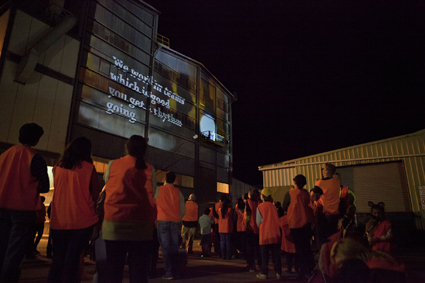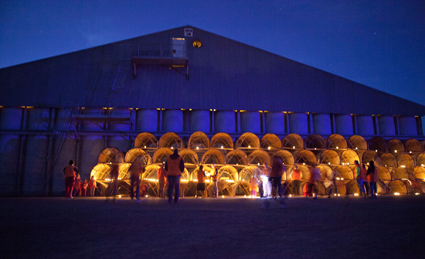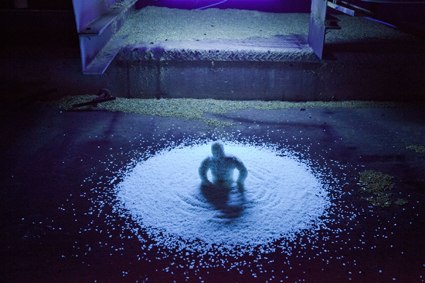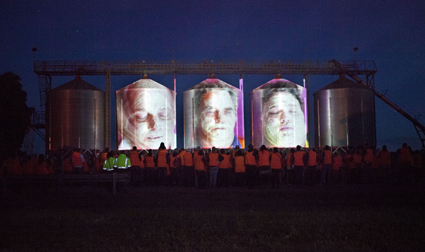Rice, rituals and relationships
Gail Priest: A Night of Wonder, The Cad Factory & SunRice, Coleambally
Video footage: Sam James, Editing: Gail Priest
* * *
Coleambally is just over 600kms south west of Sydney in the Riverina region. It’s a very young town, founded in 1968 and currently has a population of just over 600 residents. One third of them attended A Night of Wonder, at the Coleambally SunRice Mill.
Vic McEwan from the Cad Factory in Narrandera brokered a unique partnership with the SunRice corporation to have access to their mill site in Coleambally and their workers (on company time) in order to develop an evening of site specific performance and installation. Only just re-opened after drought closure in 2007, the vast factory complex incorporates facilities managed by Australian Grain Storage. Following the path that rice processing takes, A Night of Wonder led its audience to 10 sites in the mill and storage facilities,

Site 9 – Opera, A Night of Wonder, Coleambally SunRice Mill, The Cad Factory
photo Mayu Kanamori
Site 9 – Opera, A Night of Wonder, Coleambally SunRice Mill, The Cad Factory
McEwan invited artists Mayu Kanamori (Sydney) and Shigeaki Iwai (Tokyo) to collaborate with each other and the Coleambally community. McEwan and Kanamori undertook a one-week residency early in the year, at the beginning of harvest time. Subsequently they were joined by Iwai for a three week residency in Spring: planting time. The Japanese artists brought with them a very different relationship to rice from our own. Theirs is an ancient connection associated with tradition and ritual, while, as McEwan suggest in the realtime tv documentary on A Night of Wonder, in Australia rice is just rice. Of course for the community of Coleambally rice has become much more than that.
The main performance in the cavernous storage barn saw several community members—a local Aboriginal elder, a farmer, a farmer’s wife, a miller, the factory manager—have a conversation with ‘rice,’ each speaking at a microphone to a circular projection of falling rice grains. For Stan Grant, the Wiradjuri elder, it’s a conflicted relationship: rice is not native to the area, but now it helps support his people. To the farmer it’s a co-dependent relationship; to a farmer’s wife it’s one of sharing her husband with the crop he loves. The final performer is Kanamori, speaking as a bird (complete with avian headdress) about how rice fits into birds lives. (Coleambally is an Aboriginal word describing a swift in flight.) As the projected image mutates into rice fields being burnt back for a new planting, a curtain of actual rice showers down, the metaphors of fire and water and earth co-mingling. McEwan, accompanying the performance with sound produced on laptop, also plays clarinet and miked-up fixtures of the building. Placed in the centre of the journey, the performance allowed the roving audience to settle and contemplate, though the ritualistic and reverent tone felt, at times, a little too ponderous.

Site 3 – Ceremony for Planting, A Night of Wonder, Coleambally SunRice Mill, The Cad Factory
photo Mayu Kanamori
Site 3 – Ceremony for Planting, A Night of Wonder, Coleambally SunRice Mill, The Cad Factory
Ritual had been introduced with a lighter touch earlier on in the evening at the third site—a large stack of semi-circular airing baskets. Audience members were invited to ignite tea-light candles, place them in the baskets and make wishes for the new planting season. The resulting installation of hundreds of delicate flickering lights amid worn metal machinery was simply magical.

Site 5 – Of Rice & Men, A Night of Wonder, Coleambally SunRice Mill, The Cad Factory
photo Mayu Kanamori
Site 5 – Of Rice & Men, A Night of Wonder, Coleambally SunRice Mill, The Cad Factory
Shigeaki Iwai declared he was liberated by the absence of deep cultural significance in Australia around rice, his main artwork embracing instead a sense of play. In site five, an alleyway between two large warehouses, he installed a series of knee-high figures—people and animals made entirely of molded rice. These were placed in relation to old pieces of machinery illuminated with ultraviolet light. Not only did this provide a spectral glow to the figures, casting the audience’s hi-viz orange vests in terrifying contrast, but it also drew attention to the role of ultraviolet light in the rice growing process and, perhaps, the detrimental effect of too much of it given the potential for a greater hole in the ozone layer.
Mayu Kanamori got to the heart of the matter creating an installation about love. When they first arrived in Coleambally the artists held a dinner party, treating a number of community members to a 10-course rice banquet. After some sake tasting, Kanamori convinced the diners to write short poems about rice and love. These stories formed the basis of an installation featuring Kanamori’s photographs, audio recordings and small handwritten texts displayed amidst piles of golden rice husks, forming both a visual, sonic and tactile environment.

Site 4 – Rice Bran Facial, A Night of Wonder, Coleambally SunRice Mill, The Cad Factory
photo Mayu Kanamori
Site 4 – Rice Bran Facial, A Night of Wonder, Coleambally SunRice Mill, The Cad Factory
Industrial sites just beg for large-scale projections and A Night of Wonder did not disappoint. Onto three large grain storage silos a projected video showed several hardened millworkers in close-up being given facials made from rice bran, a traditional Japanese beauty therapy. Their faces loomed two storeys tall while we listened to recordings of their wives discussing how beautiful the refreshed skin felt, and how it had really made the men gentler and more relaxed. The workers themselves admitted that it was not too bad an activity, and as one wife says, she feels it has made her husband just that little bit more metrosexual.
The event culminated with a mini opera performed by a Narrandera local Fiona Caldarevic. Composed by McEwan, the lyrics were taken directly from interviews with workers in the mill about their daily routines. Caldarevic appeared as a diminutive figure on a landing protruding from the vast façade of the building onto which were projected scenes of pounding machinery (and wobbling jelly, the significance of which escaped me). Reminiscent of 70s British workers’ theatre it provided a suitably dramatic ending.
Interspersed among the art activities were several refreshment stations serving very tasty sushi rolls and hearty rice soup and everyone received a show bag of SunRice products. It was clear that the overall warm vibe at the conclusion of the evening came from much more than this generosity. A Night of Wonder managed to strike a perfect balance of engagement with its community. The ways in which the audience participated—being weighed in as if they were a rice crop, lighting candles, shuffling through rice husks—were subtle, non-confrontational, but meaningful. Perhaps more importantly, the ways in which community members were engaged were well pitched to be satisfying for them but also also fed into artistic outcomes. For a project juggling creative, community and, of course, business expectations, it really was wondrous.






